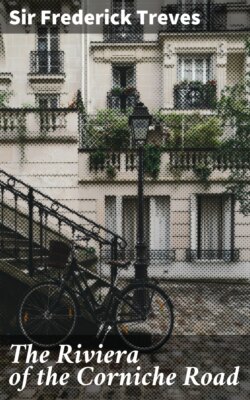Читать книгу The Riviera of the Corniche Road - Sir Frederick Treves - Страница 11
На сайте Литреса книга снята с продажи.
ОглавлениеNICE: RUE DU SENAT.
A stroll through the town will reveal many reminiscences of the past, which, although trivial enough, are still very pleasant to come upon amidst squalid surroundings. For instance over the doorway of a house in the Rue Centrale are carved, in a very boyish fashion, the letters I.H.S. with beneath them the sacred heart, the date 1648 and the initials of the owner of the building. Then again in the Rue Droite (No. 1), high up on the plain, deadly-modern wall of a wine-shop, is one very exquisite little window whose three arches are supported by two graceful columns. It is as unexpected as a plaque by Della Robbia on the outside of a gasometer.
There are several churches in the old town but they cannot claim to be notable. The cathedral of Sainte Réparate stands in an obscure and meagre square. It became a cathedral in 1531 but was reconstructed in 1737 and its interior “restored” in 1901. Outside it is quite mediocre, but within it is so ablaze with crude colours, so laden with extravagant and restless ornament, so profuse in its fussy and irritating decoration that it is not, in any sense, a sanctuary of peace. The old town hall of Nice in the Place St. François is a small, simple building in the Renaissance style which can claim to be worthy of the Nice that was.
There are two objects outside the old town which the visitor will assuredly see—the Pont Vieux and the Croix de Marbre. The former which dates from 1531 is a weary-looking old bridge of three arches, worn and patched. Any charm it may have possessed is destroyed by the uncouth structure of wood and iron which serves to widen its narrow mediæval way. The cross stands in the district once occupied by the convent of Sainte Croix which was destroyed during the siege of 1543. The monument serves to commemorate the meeting of peace held in 1538 by Pope Paul III, François I and the Emperor Charles V. The cross, which is very simple, rises under a canopy of old, grey stone, supported by pillars with very primitive capitals. The cross was hidden away during the Revolution but was replaced in 1806 by the then Countess de Villeneuve. The venerable monument, standing as it does in a busy street through which the tramcars rumble, looks singularly forlorn and out of place.
The Castle Hill is now merely a wooded height which has been converted into a quite delightful public park. Among the forest of trees are many remains of the ancient citadel, masses of tumbled masonry, a half-buried arch or a stone doorway. There are indications also of the foundations of the old cathedral. The view from the platform on the summit is very fine, while at the foot are the jumbled roofs of old Nice. It is easy to appreciate how strong a fortress it was and how it proved to be impregnable to the forces of Barbarossa in the siege of 1543. It is a hill with a great history, illumined with great memories, but these are not encouraged by the stall for postcards and the refreshment bar which now occupy the place of the old donjon.
| [2] | “La Province des Alpes Maritimes,” 1902. |
| [3] | So named after King Victor Amadeus III of Sardinia. |
| [4] | The strange wanderings of Paganini after death are dealt with in the account of Villefranche (page 114). |
| [5] | A good photograph of this staircase will be found in Mr. Loveland’s “Romance of Nice,” page 146. |
